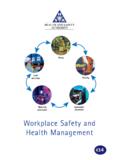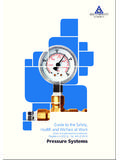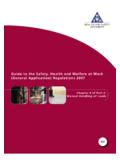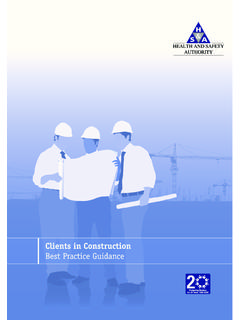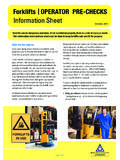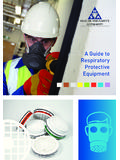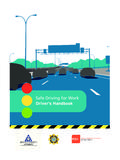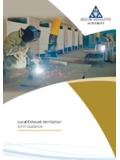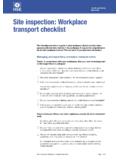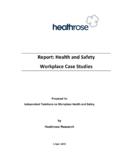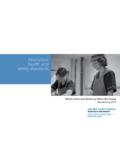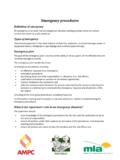Transcription of Workplace Transport Safety – Risk Assessment
1 Workplace Transport Safety . Risk Assessment Information Sheet This information sheet provides basic information on conducting a Workplace Transport risk Assessment . The information is aimed at employers, people in control of places of work, self-employed people and Safety representatives. The information may also be of interest to employees. What is a Workplace Transport Risk Assessment ? A Workplace Transport risk Assessment is the process of evaluating the risks to a person's Safety and health from any vehicle or piece of mobile equipment that is used by an employer, employee, self-employed person or a visitor, in the Workplace . It is the systematic examination of all aspects of work that may be affected by Workplace Transport and looks at the specific hazards associated with the use of vehicles and mobile equipment in the Workplace .
2 The principle purpose of carrying out a Workplace Transport risk Assessment is to reduce risk. The process forms part of the overall legal duties for employers and persons in control of places of work to conduct a risk Assessment on all activities that introduce risk. Conducting the Workplace Transport Risk Assessment When conducting the risk Assessment follow the three step process: 1. Identify Hazards: Look at what could cause injury or harm;. 2. Assess the risks of injury or harm: consider who could be harmed, how and to what extent;. 3. Control the risks : put in place control measures to eliminate or reduce the risk to as low a level as reasonably practicable. Conduct the Assessment over a reasonable period of time, such as a full working week, in order to capture the complete picture of Workplace Transport activities on your premises.
3 Ensure that a competent person carries out the risk Assessment in consultation with employees. Step 1: Identify Hazards A hazard is anything with the potential to cause harm such as work materials, equipment, work methods/practices, poor work design or exposure to harmful agents such as chemicals, noise or vibration. L Identify and list the types of vehicles that use your premises, for instance, employees' cars, forklift trucks, security vehicles, delivery vans, postal vans, large goods vehicles. Consider less common vehicles that may have to access your premises such as emergency vehicles or waste collection vehicles. L Identify and list the vehicle activities and work activities associated with the vehicles. Look at: How vehicles arrive and depart from the premises.
4 Are there certain times when vehicles arrive? Who drives the vehicles? Are there passengers? How vehicles travel around the premises. How vehicles manoeuvre when on the premises. Where do they park? Do vehicles reverse? Areas where people work around moving vehicles or work at height on vehicles. Work activities such as vehicle maintenance, loading and unloading, coupling and uncoupling and load securing activities. Normal operation and emergency activities such as vehicle breakdowns. L Use a site plan or map: mark and identify in different colours where vehicular and pedestrian movements occur on site. Where the vehicles and pedestrian activities intersect, these areas will be high risk and need to be addressed as a high priority. Step 2: Assess the risks of injury or harm A risk is the chance, high or low, that somebody may be harmed by the hazard.
5 L Identify the risks with each vehicle and activity. Think about what could go wrong. L Identify the people who may be harmed such as employees, customers, contractors, members of the public or visitors to the Workplace . Consider how often and how frequently people may be exposed to the hazard. L Think about the three elements of Workplace Transport Safety : the vehicle, the driver and the Workplace The Authority's Workplace Transport checklist and associated Information Sheets may be of assistance here. L Consider could someone: Be hit, run over or crushed by a vehicle? Fall from a vehicle? Overturn a vehicle? These are the some of the most common causes of Workplace Transport fatalities. L Are there: Overhead obstructions on site, such as electrical cables or pipes, could a vehicle hit these?
6 Overgrown trees on site which could affect load stability on a vehicle? L Take account of certain periods of the day when the number of vehicles and pedestrians moving along routes changes such as shift changes or delivery times. Do you need to restrict vehicle or pedestrian movements at these times? L Consider different times: Day time versus night time: Is signage visible at night time? Is the site well lit? Summer versus winter: Are there icy or slippery areas on site in winter? L Consider are the vehicles being used for the correct purpose, for instance, a person using a pallet on a forklift to access heights is not correct use of the forklift and such unsafe practices must be prohibited. L Consider how likely it is that the hazard will cause harm and how serious that harm is likely to be.
7 This will help prioritise the risks . L Don't just think of physical injuries to people think about long term health effects also, such as the effects of: Noise;. Vibration;. Poor ergonomics;. Exposure to vehicle fumes. L Consult with people like drivers, employees, contractors and visitors during the risk Assessment process. They may recognise problems or solutions that you do not see. L Take account of any accidents, incidents or near misses look at the accident book to see if there have been any previous problems with Workplace Transport . Step 3: Control the risk L Consider what controls are already in place (if any). Are they good enough or should more be done to prevent accident or injury? Review your Workplace , the vehicles, the drivers and your systems of work and compare your controls with existing good practice.
8 L Take account of the general principles of prevention (Schedule 3 of the 2005 Act). and how they may be applied to Workplace Transport . For example: L Stop vehicle movements on your premises or in areas where pedestrians Avoid the risk work. L Stop reversing manoeuvres on your premises. Evaluate L Where vehicle movements or work activities involving vehicles cannot be unavoidable eliminated, evaluate the risk. L Consider are your existing precautions adequate or should more be done risks to prevent accident or injury. L Segregate vehicles and pedestrians as soon as they enter your Workplace . Make pedestrian only or vehicle only areas. Combat risks L Change the layout of the Workplace , consider putting in a one way traffic at source system and remove the need for reversing.
9 L Provide the right vehicle for the right job. Maintain the vehicle. L Ensure that drivers are appropriately trained and competent and where applicable have the correct licence/card for the vehicle being driven. L Ensure that the vehicle and the driver are compatible. Adapt work to L The driver has good all round visibility. The vehicle is ergonomically suitable for the driver. the individual L. L The driver is not put under unnecessary pressure or time constraints to complete tasks. Adapt place of work to L Review your premises, for instance can you put in new engineering technical controls, such as vehicle turntables which eliminate reversing or speed restricting devices, cameras etc. on vehicles. progress Replace L Replace unsafe vehicles, loading facilities, road signage, surfaces or dangerous systems of work with safer ones.
10 Articles/systems L Ensure all obstructions (overhead and ground level) are clearly visible. L If you have a small site consider do you need to restrict the size of of work vehicles entering your site? Collective L Put in place protective measures that protect everyone not just an protective individual. L For instance, install pedestrian barriers, handrails, separate access ways measures for pedestrians and vehicles. Develop L Document your traffic management system (traffic management plan, Workplace Transport risk Assessment , safe systems of work etc.). prevention L Introduce work practices that reduce the risk such as restricting policies pedestrian access at times when there is a lot of vehicle movement. L Enforce speed limits. L Train & instruct all employees about the dangers of Workplace Transport .

